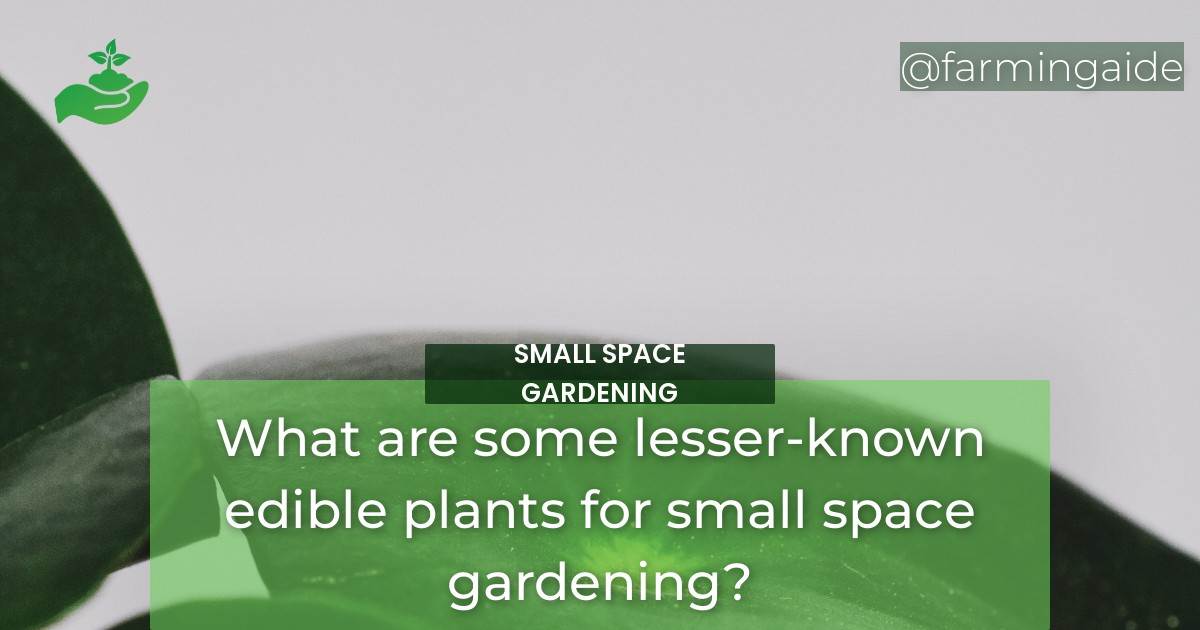Small space gardening is an excellent way to grow fresh produce, even if you don’t have a lot of outdoor area. However, finding suitable plants can be a challenge, especially if you’re looking for something different from the usual herbs and tomatoes. In this article, we’ll explore some lesser-known edible plant choices for limited space gardens that are both unique and delicious.
Uncommon Edible Plant Choices for Limited Space Gardens
Introduction to Small Space Gardening
Small space gardening refers to the practice of growing plants in areas with limited square footage, such as balconies, patios, or small yards. The goal is to maximize the use of available space by growing vertically or in containers.
The benefits of small space gardening include:
- Access to fresh, organic produce
- Savings on grocery bills
- Improved air quality
- Reduced carbon footprint
However, small space gardening also poses some challenges, such as:
- Limited space for planting
- Restricted sunlight exposure
- Inadequate soil quality
- Difficulty in pest and disease management
Criteria for Choosing Uncommon Edible Plants for Small Space Gardens
When selecting plants for small space gardens, it’s important to consider several factors, such as:
- Nutritional value: Choose plants that are rich in essential vitamins and minerals.
- Yield: Select plants that produce a high volume of harvestable food.
- Space requirements: Opt for plants that can grow vertically or in compact spaces.
- Growing conditions: Pick plants that are suitable for your climate and available sunlight.
- Availability: Look for seeds or seedlings that are easy to find in your local nursery or online.
Uncommon Edible Plants for Small Space Gardens
Microgreens
Microgreens are young plants that are harvested when they are only a few inches tall. They are easy to grow and require little space, making them ideal for small gardens. Some of the best microgreens to grow include:
- Arugula
- Radish
- Kale
- Broccoli
- Beet
Microgreens are rich in vitamins and minerals and can be used to add flavor and nutrition to salads, sandwiches, and smoothies.
Malabar Spinach
Malabar spinach is a unique edible plant that thrives in hot and humid climates. It’s a climbing vine that can be grown vertically, making it ideal for small gardens. Malabar spinach is rich in vitamins A and C and contains iron, calcium, and magnesium.
To grow Malabar spinach, you’ll need a trellis or a support system for the vine to climb on. The plant prefers well-draining soil and partial shade.
Yardlong Beans
Yardlong beans are a type of Asian bean that can grow up to 3 feet long. They are easy to grow and can produce a high yield in a small space. Yardlong beans are rich in fiber, vitamin C, and folate.
The best way to grow yardlong beans in limited space gardens is to use a trellis or a vertical support system. You can also try growing them in containers using a compact variety.
Chile Peppers
Chile peppers are a spicy addition to any small garden. They are easy to grow and can be grown in containers. Chile peppers are rich in vitamin C and capsaicin, which has anti-inflammatory properties.
When growing chile peppers in small spaces, it’s important to select a compact variety and use well-draining soil. Place the container in a sunny spot and water regularly.
Edible Flowers
Edible flowers are a beautiful and nutritious addition to small gardens. Some of the best edible flowers to grow include:
- Calendula
- Nasturtium
- Violet
- Borage
- Rose
Edible flowers can be used to add color and flavor to salads, desserts, and cocktails. They are rich in antioxidants and can provide several health benefits.
Micro Tomatoes
Micro tomatoes are a compact and flavorful variety of tomatoes that are easy to grow in small spaces. They produce small fruits that are packed with vitamins and antioxidants.
To grow micro tomatoes, choose a compact variety and use a well-draining soil mix. Place the container in a sunny spot and water regularly.
Tips for Growing Uncommon Edible Plants in Small Spaces
Here are some tips to help you grow uncommon edible plants in small gardens:
- Choosing the right container: Select a container that is large enough to support the plant’s growth but not too bulky to fit in your small space.
- Soil selection: Use a soil mix that is rich in organic matter and well-draining to prevent waterlogging.
- Watering and fertilizing: Water your plants regularly and fertilize them with a balanced organic fertilizer to promote healthy growth.
- Pest and disease management: Keep an eye out for pests and diseases and take necessary measures to prevent or control them.
- Harvesting and storage: Harvest your plants regularly and store them properly to avoid spoilage.
Conclusion
Growing uncommon edible plants in small spaces can be a fun and rewarding experience. By selecting plants that are rich in nutrition and easy to grow, you can enjoy fresh produce even if you don’t have a lot of outdoor area. We hope this article has provided you with some insight into the best lesser-known edible plants for small space gardening.
Remember, the benefits of growing uncommon edible plants include access to unique flavors, health benefits, and cost savings. Give it a try and see how your small space garden can flourish!


